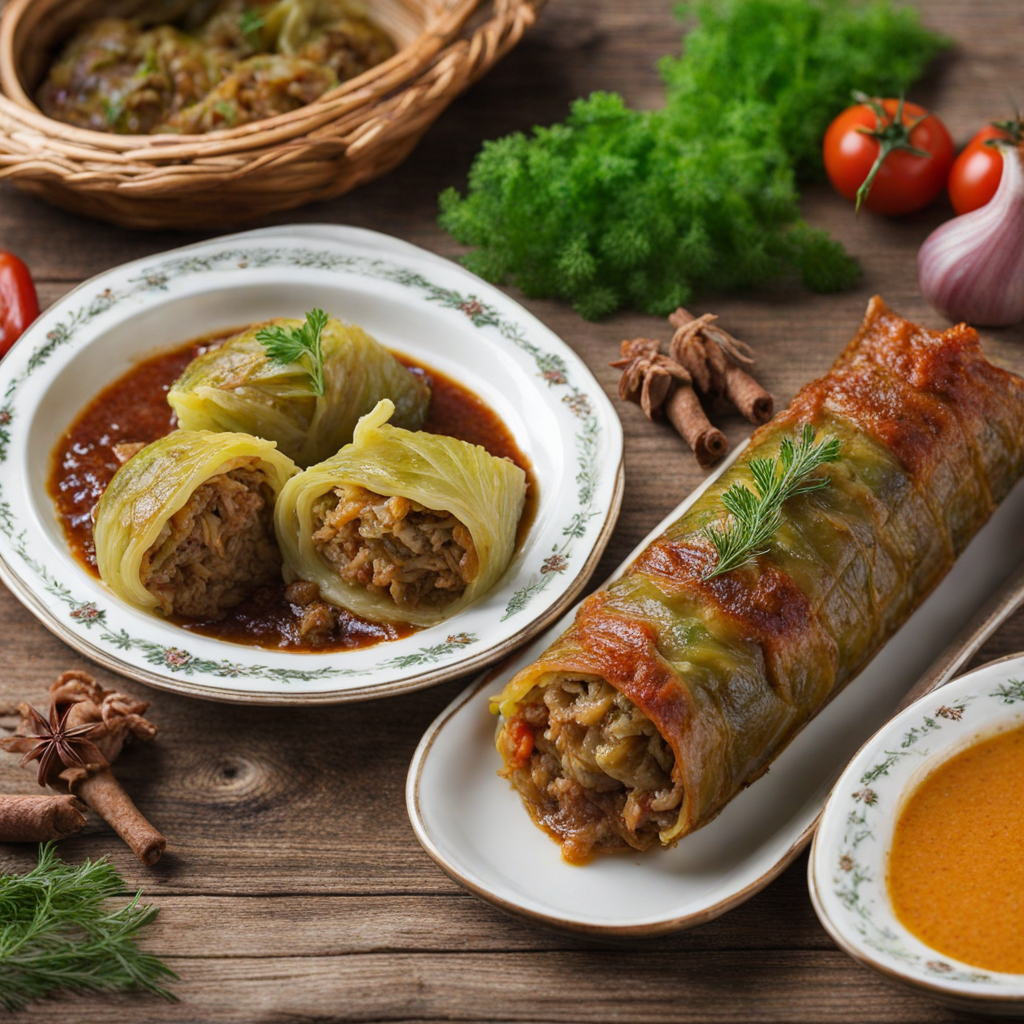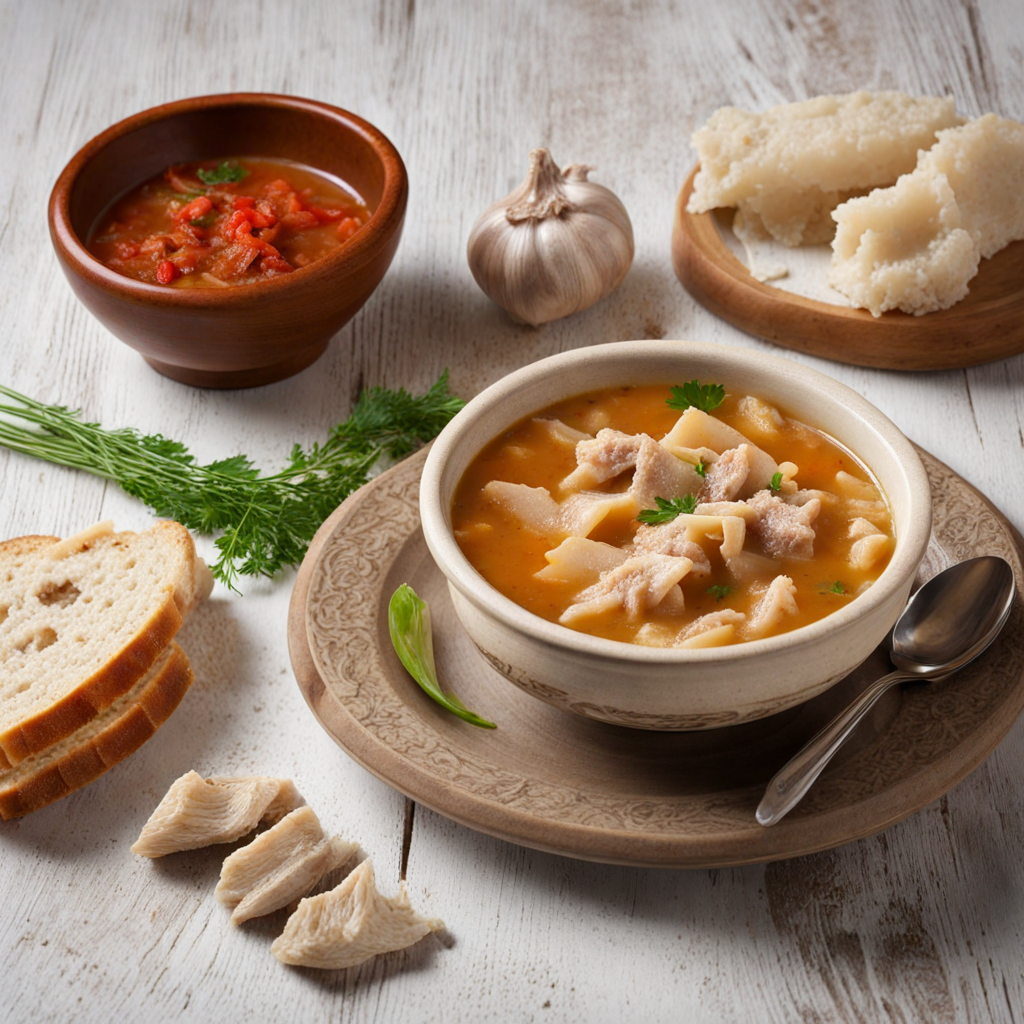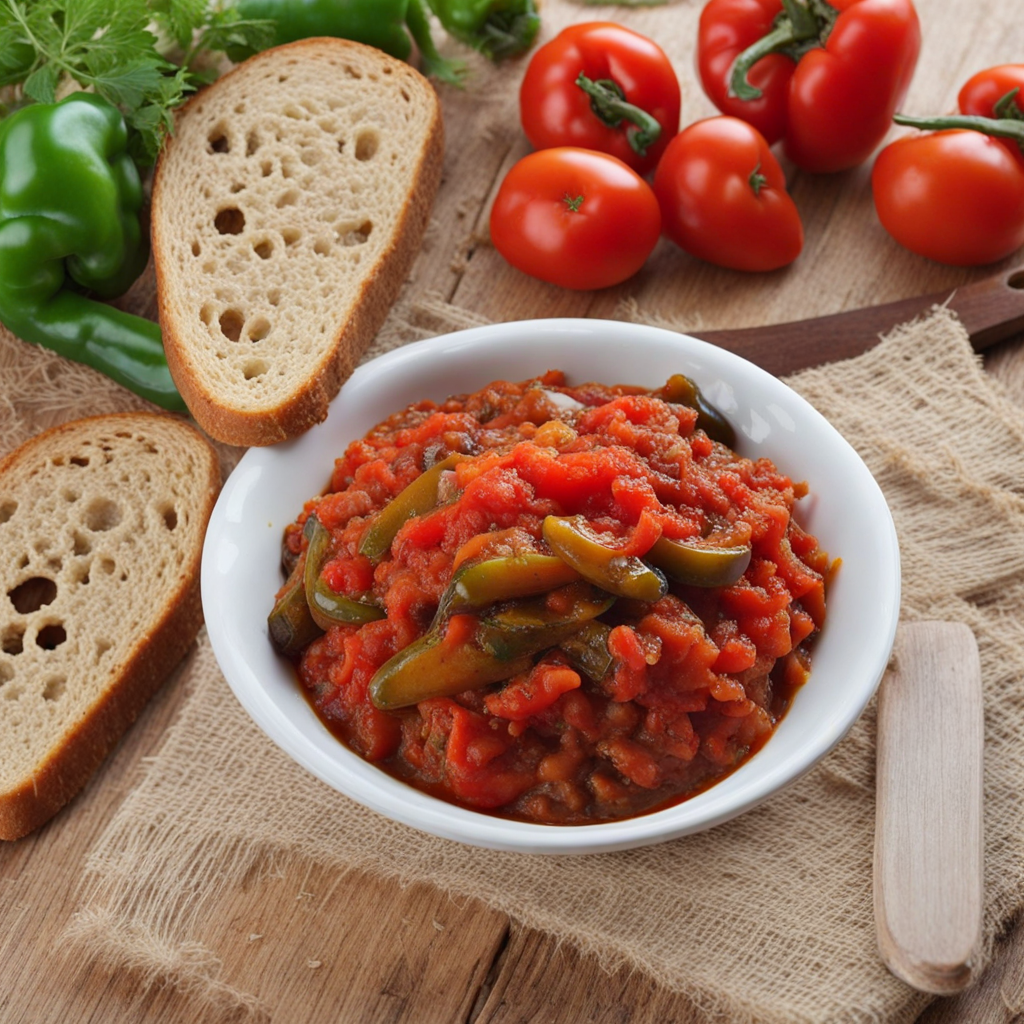Sarmi
Sarmi is a traditional Bulgarian dish that showcases the rich culinary heritage of the region. At its core, Sarmi consists of tender grape leaves or cabbage leaves stuffed with a flavorful mixture of minced meat, typically pork or beef, combined with rice and a blend of aromatic spices. The leaves, when wrapped around the savory filling, create a delightful parcel that is both comforting and satisfying. The dish is often seasoned with fresh herbs such as dill and parsley, giving it a bright and refreshing taste that perfectly complements the richness of the meat and rice. As Sarmi is cooked, it is usually simmered slowly in a pot with a splash of tomato sauce or broth, allowing the flavors to meld together beautifully. The gentle cooking process ensures that the leaves become tender and absorb the savory essence of the filling. This method creates a dish that is not only delicious but also visually appealing, with the vibrant green of the leaves contrasting with the warm hues of the filling. Traditionally served as a main course, Sarmi can be enjoyed hot or at room temperature, making it a versatile dish for any occasion. It is often accompanied by a dollop of yogurt or a sprinkle of lemon juice, enhancing the flavors and adding a refreshing tang. Whether enjoyed during festive occasions or as a comforting family meal, Sarmi is a delightful representation of Bulgarian cuisine that invites you to savor its unique tastes and textures.
How It Became This Dish
The History of Сарми: A Culinary Tradition of Bulgaria #### Origins and Etymology Сарми (sarmi) are a traditional Bulgarian dish that consists of grape leaves or cabbage leaves stuffed with a mixture of rice, minced meat, and various spices. The name "sarmi" is derived from the Turkish word "sarmak," which means "to wrap." This culinary practice of wrapping is not just characteristic of Bulgarian cuisine but is also found in numerous cultures across the Balkans and the Middle East, reflecting the region's complex history of cultural exchange and migration. The origins of sarmi can be traced back to the early interactions between the Ottoman Empire and the Balkan peoples. As the Ottomans expanded their territories, they brought with them a wealth of culinary traditions, including the art of wrapping ingredients in leaves. Although the exact timeline is difficult to pinpoint, it is believed that the dish has been adapted and transformed through centuries of local influence, resulting in a uniquely Bulgarian version that emphasizes local ingredients and flavors. #### Cultural Significance Sarmi hold a special place in Bulgarian culture, often served during important celebrations and family gatherings. They are especially popular during Christmas, New Year's Eve, and various religious holidays, where they symbolize prosperity and abundance. The preparation of sarmi is often a communal activity, involving family members coming together to prepare the dish, which fosters bonds and strengthens familial ties. In Bulgarian folklore, food plays a significant role in rituals and traditions, reflecting a deep connection to the land and its agricultural bounty. Sarmi embody this link, as they utilize ingredients that are locally sourced. The use of grape leaves in particular is a nod to Bulgaria's ancient viticulture, with vineyards dotting the landscape for centuries. This dish, therefore, not only nourishes the body but also connects people to their heritage and the land from which they come. #### Ingredients and Preparation The basic components of sarmi vary slightly depending on the region and personal preferences but generally include grape or cabbage leaves, rice, minced meat (often pork or beef), and an array of spices such as dill, black pepper, and paprika. Some variations incorporate vegetables like carrots or even nuts to enhance flavor and texture. Preparation begins with the careful selection of leaves. Grape leaves can either be fresh or preserved in jars, while cabbage leaves are typically blanched to soften them for wrapping. The filling is made by sautéing the meat, mixing it with rice and spices, and sometimes adding finely chopped onions or herbs. Each leaf is filled with a small amount of this mixture, then carefully wrapped and placed in a pot. The sarmi are traditionally cooked slowly in a tomato-based sauce or broth, allowing the flavors to meld and infuse throughout the dish. In modern times, vegetarian versions of sarmi have also emerged, particularly among those seeking healthier options or adhering to dietary restrictions. These variations often include lentils, bulgur, or other grains, combined with herbs and spices to create a flavorful filling. #### Development Over Time As Bulgaria transitioned through various political and social changes, so too did the dish of sarmi. The 20th century brought about significant shifts in culinary practices, with globalization influencing local foodways. The rise of convenience foods and fast-casual dining led to changes in how sarmi were prepared and consumed. While traditional recipes remained popular, many households began to adopt quicker cooking methods and store-bought ingredients. Despite these changes, the essence of sarmi endures as a beloved dish that evokes nostalgia and a sense of home for many Bulgarians. In recent years, there has been a resurgence of interest in traditional cooking, with younger generations seeking to reconnect with their culinary heritage. Food festivals and cultural events often feature sarmi as a highlight, showcasing the dish's importance in contemporary Bulgarian identity. #### Regional Variations Throughout Bulgaria, regional variations of sarmi reflect local tastes and available ingredients. In the southern regions, for example, it is common to find sarmi made with fresh grape leaves, while in the north, cabbage leaves are more prevalent. Additionally, some areas might add unique local spices or herbs to their filling, contributing to the diversity of flavors found in Bulgarian sarmi. The influence of neighboring countries is also evident in the variations of this dish. In Greece, for example, the dish known as "dolmas" shares similarities with sarmi, although it often incorporates different spices and may include a lemony sauce. This cross-cultural exchange highlights the interconnectedness of Balkan cuisines and the shared culinary heritage that transcends borders. #### Modern Interpretations and Global Recognition In the 21st century, the globalization of food culture has led to a broader appreciation of traditional dishes like sarmi beyond Bulgaria's borders. With the rise of culinary tourism, visitors to Bulgaria are increasingly eager to experience authentic local cuisine, and sarmi has become a must-try dish. Bulgarian restaurants around the world are introducing sarmi to new audiences, presenting it as a symbol of Bulgarian hospitality and cultural pride. Moreover, social media has played a significant role in popularizing sarmi, with food bloggers and culinary enthusiasts sharing their versions of the dish, often experimenting with innovative twists while honoring traditional methods. This blend of tradition and modernity ensures that sarmi remains relevant in contemporary culinary discourse. #### Conclusion Sarmi are more than just a dish; they are a testament to Bulgaria's rich cultural tapestry, reflecting centuries of history, tradition, and community. Their journey from the kitchens of our ancestors to modern tables is a narrative steeped in connection—to family, to the land, and to one another. As Bulgaria continues to evolve, sarmi will undoubtedly remain a cherished culinary symbol, bridging the past with the present and continuing to nourish both body and spirit for generations to come.
You may like
Discover local flavors from Bulgaria







